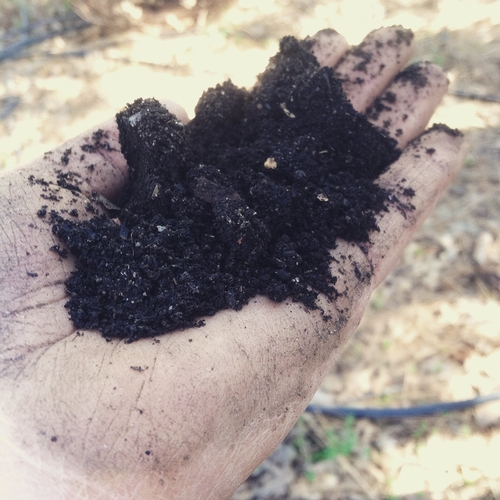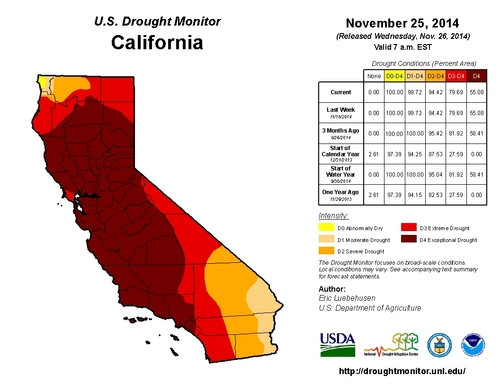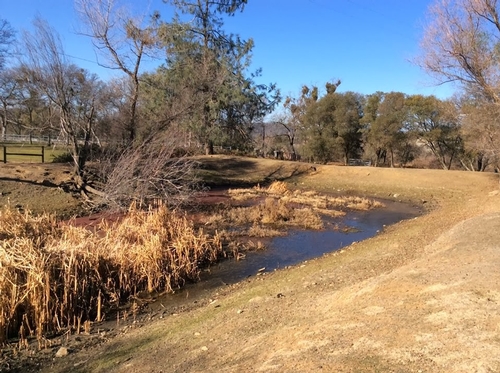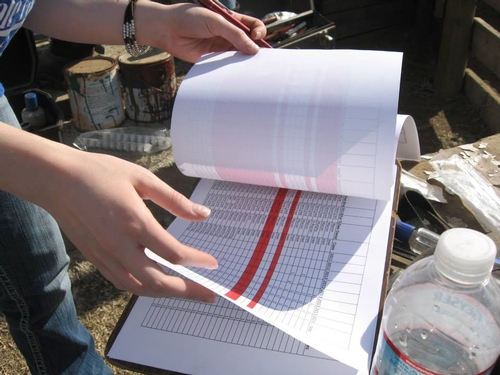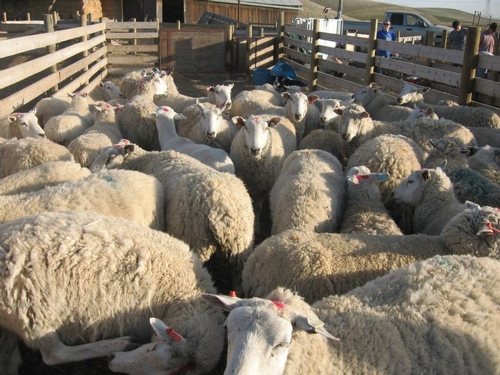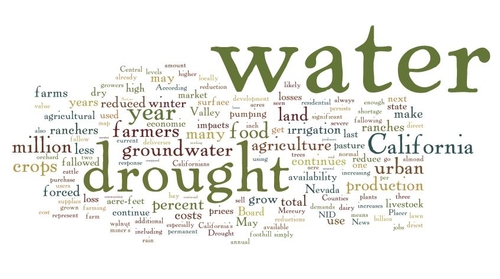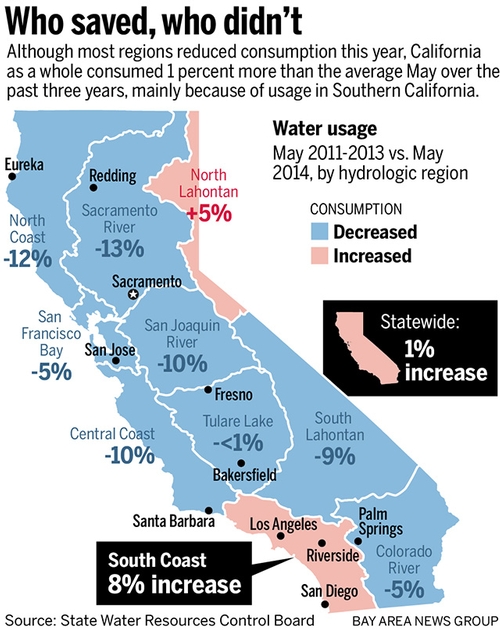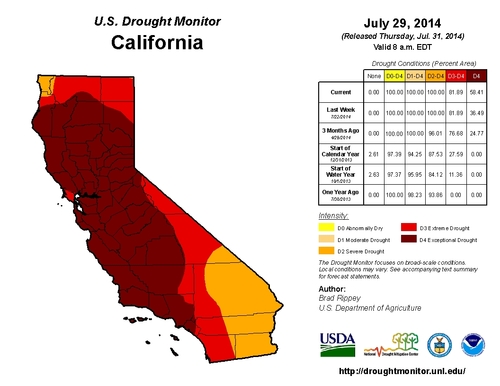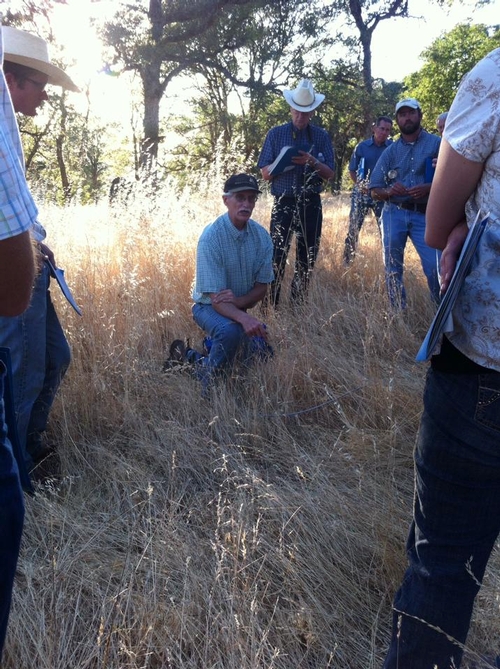Posts Tagged: drought
Planning for Drought Resilience
A quick scan of drought related news is not good for my anxiety levels. A March 21st article in The Atlantic reports how our warmest winter in 100 years (by 4.4 degrees on average) is impacting agriculture across California: 17,000 farmers lost their jobs in 2014 and cost the ag sector $2.2 billion. For the first time in 75 years, the Department of Water Resources Sierra snowpack survey for April 1st had no snow to survey. The 2012-2014 California drought is reported to be the worst in 1,200 years! I am growing tired of watching the weather forecast as well. The pattern thus far: a storm is forecast, the storm arrives and delivers a fraction of what was expected. My new plan is to stop focusing on the lack of rain and snow and start getting serious about building drought resilience into our farm plan.
The reality is that we won't be able to sink a new well or dig a new pond. We are a small farm with very limited capital purchasing power. Does our lack of financial wiggle room mean that this drought may put us out of business? I am hopeful that we can continue to farm within the new parameters that this drought may impose on our business. But we won't be able to do this without a plan.
What is the worst case scenario on your farm or ranch? On my own farm, the worst case scenario would be the complete suspension of our irrigation water allotment. If our water allotment was drastically decreased, could we still make a profit from our farm? Here's a look at what we are planning to do to increase the drought resilience of our land and business.
A simple first step is to increase our soil organic matter. We traditionally grow both summer and winter cover crop on fallow ground. This summer's growing season, we are taking even more land out of row crop production and will plant more summer cover crops. Our favorite is sorghum Sudan grass. Unlike Johnson grass which it is very similar to in appearance, Sudan grass does not grow rhizomes and spread underground. It requires very little water and is a great way to protect open ground in the summer. According to UCCE Horticulture and Small Farms Advisor, Cindy Fake, a 1% increase in soil organic matter results in an additional 16,000 gallons of water retained per acre foot of soil! That is a lot of water. This ATTRA publication has a lot of information on creating drought resilient soils: http://cses.uark.edu/ATTRA_drought.pdf
Another goal this season is to understand exactly how much forage our pigs are able to access from the irrigated pastures we raise them on. I want to know exactly what it would cost if we had to buy in all of the feed for our animals. Understanding the financial impact that the loss of our irrigation water would have on our farm will help us make decisions about the size of our hog herd. If we decrease by 25%, can we keep our feed bill affordable? If there was no water at all, how much would it cost to keep our breeding animals alive?
We irrigate our row crops as efficiently as we can. We deliver water through drip tape and irrigate in the evenings once the day has cooled and evapotranspiration loss is decreased. But I am finding that this is still not enough to make our farm truly drought resilient. I need to know at what point in the growth cycle the crops I produce are most susceptible to water stress. In other words, how can I achieve profitable yields with the least amount of water possible? If I had to use my residential water supply to grow a crop, what is the least amount of water I could utilize without seriously impacting yield? Here is a link to a publication on water efficiency and the critical periods for water stress in orchard crops and vegetables: http://ucanr.edu/sites/placernevadasmallfarms/files/180093.pdf.
Understanding the economics of each of my crops is vital to drought resilience. I need to know which crops to prioritize in the face of limited irrigation water. Are dahlias or sunflowers a more profitable crop for us? Can we increase our early season production and limit production when the temperatures hit the high 90s? I cannot make these decisions without a thorough understanding of the income and expense associated with each crop. The crop metric calculators created by UC Extension can assist you in determining the profitability of each crop you grow. http://ucanr.edu/sites/placernevadasmallfarms/UCCE_Enterprise_Calculators/. By combining my understanding of which crops need water and when with my knowledge of income and expense for each crop, I can begin to create my drought contingency crop plan.
Out of habit, I just checked the weather forecast and saw that some rain is predicted for the end of the week. The predicted moisture will help the cover crop and pasture grow, but it won't alter the long term effects of this drought.
News links and References:
http://www.theatlantic.com/business/archive/2015/03/the-economics-of-californias-drought/388375/
http://www.water.ca.gov/news/newsreleases/2015/040115snowsurvey.pdf
Scott, H.D., L.S. Wood, and W.M. Miley. 1986. Long-term effects of tillage on the retention and transport of soil water. Arkansas Water Resources Research Center. Publication Number 125. 39 p.
Measuring the Drought: How Farmers and Ranchers Can Report on Drought Impacts
In early November, the California Rangeland Watershed Laboratory at UC Davis hosted a workshop/webinar entitled “Ranching and California's Drought” (for videos of the presentations, CLICK HERE). For me, one of the most interesting parts of the workshop was a panel discussion featuring several of the authors of the U.S. Drought Monitor (go to http://droughtmonitor.unl.edu/ for more information about the Drought Monitor). According to the Drought Monitor website:
“The U.S. Drought Monitor, established in 1999, is a weekly map of drought conditions that is produced jointly by the National Oceanic and Atmospheric Administration, the U.S. Department of Agriculture, and the National Drought Mitigation Center (NDMC) at the University of Nebraska-Lincoln. The U.S. Drought Monitor website is hosted and maintained by the NDMC.
“U.S. Drought Monitor maps come out every Thursday morning at 8:30 eastern time, based on data through 7 a.m. the preceding Tuesday. The map is based on measurements of climatic, hydrologic and soil conditions as well as reported impacts and observations from more than 350 contributors around the country. Eleven climatologists from the partner organizations take turns serving as the lead author each week. The authors examine all the data and use their best judgment to reconcile any differences in what different sources are saying.”
This weekly map is important for several reasons, not the least of which is the fact that it is increasingly used to determine eligibility for government-funded drought relief programs for farmers and ranchers. It's also used by the Internal Revenue Service to determine how long a rancher who has sold breeding stock can defer his or her capital gains tax bill. I learned during the workshop that the Drought Monitor authors rely on on-the-ground observations as well as remotely-sensed data on soil moisture, precipitation, vegetation and a variety of other factors. Most applicable to me, the panel discussed ways that farmers and ranchers can provide real-world information to the Drought Monitor, which will help them improve its accuracy and timeliness.
What types of information are useful?
Obviously, on-the-ground information about precipitation is critical information. Rainfall and snowfall amounts can vary greatly over short distances, and actual precipitation totals are an important dataset for the Drought Monitor. Most of us have rain gauges – we should be recording daily rain and snowfall totals for our own records!
The panel indicated that information on forage production and other vegetation responses to precipitation are most useful when placed in historical context – in other words, reporting that our annual rangelands produced 2,000 pounds of forage per acre in 2014 isn't as useful as providing documentation that last year's forage production was 77 percent of the historic average. That said, many of us have taken photographs of our farm or ranch on an annual basis – and these photographs often show differences in vegetation from one year to the next. I've started using an iPhone application called GrassSnap (go to http://centralsandhills.unl.edu/GrassSnap for more information) that allows me to take repeatable photographs from a specific spot. I'm going to start taking these photos of our home pasture on the first of every month – a quick and easy way to track forage production from month-to-month and year-to-year.
Another useful bit of data that I've been tracking (without realizing it might be important to the Drought Monitor) are bloom and leaf-out dates for some of the landscaping plants at our home. I've recorded the bloom dates for our lilacs for the last 13 years. I've also recorded bloom dates for our daffodils. Weather and soil moisture can impact these dates, and this information (because I've got some historical context for it) is useful for the Drought Monitor. I've also recorded the dates when I first see the blue oaks starting to leaf out – another helpful indicator. We have four enormous mulberry trees in our yard – I've generally tried to record the date when they've finally dropped all of the leaves (and when we can stop raking them up!). All of this information is related to our weather conditions.
Speaking of dates, there are other useful weather and climate related dates we might record - the date of the first killing frost, for example. I've also recorded the date when I first hear or see the sandhill cranes flying over – either on their trip north in the early spring or their return trip south in the early fall. There may be other types of migratory wildlife on our farms and ranches that can help provide some indication of weather and climatic conditions. The dates when creeks start or stop running are useful information, as are the dates when vernal pools or stockponds start to fill or become dry.
In addition to these weather-related impacts, many of us have experienced management and economic impacts from the drought. Have you sold livestock because of lack of forage or stockwater? Have you had fruit trees die? Have you had your irrigation water deliveries curtailed? Have groundwater levels dropped? Have you observed health issues in your livestock or crops that might be weather related? For example, we experienced a fairly severe outbreak of the bluetongue virus this fall, which was probably related to the relatively mild and very dry winter of 2013-2014. The Drought Monitor uses these types of reports to quantify the economic impacts of drought.
I'm incredibly busy – why should I take time to observe and report conditions? Isn't that the government's job?!
All of us are busy – ranching and farming provide “opportunities” to work more than full time for most of us! Recording the types of information I've listed above takes time, as does submitting reports to the Drought Monitor. While improving the accuracy of the Drought Monitor is an important goal on its own, I've found that recording this data helps me become a better manager. For example, tracking rainfall totals last year helped me identify some critical dates for making decisions about stocking rates based on what our forage production was likely to be two or three months in the future. Someone once said that drought can sneak up on you – it's not like a snowstorm that's predicted days or weeks in advance. Keeping track helps reduce the element of surprise!
For me, at least, recording and reporting my observations is important psychologically, too. Most of us probably experienced a feeling of helplessness at some point last winter when we were in the midst of our 50-plus day dry spell. No matter how hard I tried, I couldn't make it rain. Keeping track of weather and climatic conditions – and reporting on these conditions to the Drought Monitor – gave me something useful to do. This might seem like a stretch, but there's something to it, at least for me – doing something is better than doing nothing!
How can I report drought impacts and conditions to the Drought Monitor?
There are several formal avenues for reporting impacts and conditions to the Drought Monitor. First, the National Drought Mitigation Center maintains a drought impacts reporting website (go to http://droughtreporter.unl.edu/). By clicking on the “Submit a Report” button at the top of the page, you can follow the simple, on-screen directions to submit your observation. The site is moderated, which means someone at the Center reviews each report and determines whether it can be considered a drought “impact” which can be used to inform the drought monitor map. Again, historical context is important - when you make a report, compare current conditions to previous years. For instance, you might report that a particular creek has never gone dry in the 50 years you've observed it. You can submit regular monthly observations as a “condition report ” to help build a historic record; summary information, such as how forage production compares to the historic average; or other observations or qualitative information on how drought conditions differ from normal.
I've also created an account on the Community Collaborative Rain, Hail and Snow Network (http://www.cocorahs.org/). This website allows me to report daily precipitation observations. To ensure uniformity, the network asks members to use a specific rain gauge (and a link to an affordable source of these gauges is provided). The Drought Monitor authors do review precipitation reports on the network website as they make their weekly updates. As an admitted weather nerd, I've also found the daily precipitation maps generated on this website to be very interesting – it's just one more way of “looking over the fence” to see what's happening at the neighbors!
The importance of our stories!
Finally, qualitative information about the drought is just as important as quantitative data. Our stories have importance, too – both for current research and future generations. This drought is the most severe in a generation. We need to share our stories with our families and with our neighbors – the colors on the Drought Monitor map will only impact public policy if we are willing to share the real-world effects on our land, our businesses, our families and our communities. Fortunately, most of us have access to technological tools that make recording our stories easy. One of the best sites I've seen for recording these stories is the SoundCloud Voices from the Drought site moderated by Brad Hooker at the UC Davis Plant Sciences Department. For more information about the project, go to //ucanr.edu/blogs/blogcore/postdetail.cfm?postnum=13098. To listen to the Voices from the Drought stories, go to https://soundcloud.com/groups/farmer-and-rancher-voices-from-the-drought.
Dan Macon is a Community Education Specialist in the Placer/Nevada office of UC Cooperative Extension. Dan and his family also operate Flying Mule Farm, a small-scale commercial sheep ranch in the Sierra Nevada foothills. For more information, go to www.flyingmule.blogspot.com.
The Drought Persists
Last week, the San Jose Mercury News published an interesting map of the state of California depicting “urban” (that is, non-agricultural) water use by region for the month of May. According to the State Water Resources Control Board, Californians used one percent more water in May 2014 that the average May over the last three years. Even in Placer and Nevada Counties, some residents don't comprehend the severity of the current drought.
In response to the slight uptick in urban water use compared to the last three years, the Board adopted new penalties for wasting water in urban and residential settings. This comes on top of Board actions that restrict water diversions and storage for “junior” water rights holders. Furthermore, irrigation water deliveries from the federal Central Valley Project and the state water project are vastly reduced this year. In Placer and Nevada Counties, our water agencies have asked for voluntary 15 percent reductions in water use to ensure that they can carryover enough water in reservoirs for next year.
On the same day that the Mercury News printed this graphic, the UC Davis Center for Watershed Sciences released its “Economic Analysis of the 2014 Drought for California Agriculture.” Lest there be any doubt that California is in the midst of a severe drought that is having profound impacts on farmers and ranchers, here are a few of the study's key findings:
- California is enduring its third driest year on record as agricultural, urban and environmental demands for water are at an all-time high. In other words, this year has been one of the driest in our history – and California's population has never been higher.
- The 2014 drought is responsible for the greatest absolute reduction to water availability for agriculture ever seen, given the high agricultural demands and low streamflows and reservoir levels. Surface water availability is expected to be reduced by about one-third.
- The 2014 drought will result in a 6.6 million acre-feet reduction in surface water available to agriculture. This loss of surface water will be partially replaced by increasing groundwater pumping by 5 million acre-feet.
- The net water shortage of 1.6 million acre-feet will cause losses of $810 million in crop revenue and $203 million in dairy and other livestock value, plus additional ground water pumping costs of $454 million. These direct costs to agriculture total $1.5 billion.
- The total statewide economic cost of the 2014 drought is $2.2 billion, with a total loss of 17,100 seasonal and part-time jobs.
- California farmers will fallow approximately 428,000 acres of farmland in 2014 (other reports put this estimate as high as 800,000 acres). Most of the fallowed land is estimated to be feed and other annual crops, including pasture. At the individual farm level, fallowing land creates significant cash-flow challenges. Some farms may not survive economically; some may be forced to sell land for development. These farms and ranches grow food for all of us! Each fallowed acre reduces the amount of food and fiber available for all Californians!
- In the Central Valley, high-value crops including vegetables, non-tree fruits and permanent crops represent less than 13 percent of total fallowing as growers direct scarce water to the highest value use. Scarce water supplies are being used to keep almond, pistachio and walnut trees alive, rather than to grow annual field crops. These orchard crops represent significant capital expenditures; farmers can't simply fallow an orchard one year and resume production the next.
- Alfalfa hay prices have increased 40 percent since January 2014. This impacts the cost of production for dairy farmers, and to a lesser extent, for other livestock producers. Many foothill ranchers have already felt the impacts of this price increase; they had to purchase hay to make it through the exceptionally dry winter. Ranchers who market directly to consumers have had to raise their meat prices.
- The California drought, especially the lack of rain in the winter of 2013-2014 reduced pasture quality and the number of cattle [and other rangeland livestock] per acre substantially during the crucial winter and spring period of calving and raising feeder cattle on pasture. Once the grass started to grow in March and April, many ranchers did not have enough animals to fully utilize the forage, creating fuel-loading problems on many ranches. Several wildfires this summer have impacted ranches that were forced to de-stock during the winter.
- The combined socioeconomic (reduced production, job losses, economic losses, etc.) effects of the 2014 drought are up to 50 percent more severe than in 2009.
But what happens if the drought continues? According to the report, “Statistically, the drought is likely to continue through 2015 – regardless of El Nino conditions.”
- Failure to replenish groundwater in wet years will continue to reduce groundwater availability to sustain agriculture – particularly more profitable permanent crops – during California's frequent droughts. The recent plantings of almond and walnut orchards on the edges of the Valley are at risk.
- If the drought continues for two additional years, groundwater substitution will remain the primary response to surface water shortage, with decreases in groundwater pumping capabilities and increasing costs due to declining water levels.
- A continued drought also increases the vulnerability of agriculture, as urban users with largely adequate supplies in 2014 would likely buy water from agricultural areas. This means more land will be fallowed and more farms will go out of business.
Obviously, rural communities are especially vulnerable to the drought. Communities that depend on farming and ranching as their economic base are already suffering from the loss of jobs and farming income. Drought-induced reductions in food production (and related increases in production costs) will ultimately lead to higher food prices – at the supermarket as well as at the farmers' market. As the housing market recovers, many farm and ranch families may decide to sell their land for development.
So what can we do? We can't make it rain – believe me, I've tried everything I can think of! As farmers and ranchers, we must continue to hope for the best but prepare for the worst. We need to develop drought plans – what will we do if the drought continues? For my family's sheep operation, this means keeping a careful eye on our carrying capacity and stocking rates. For foothill fruit growers, this may mean deciding which trees to save and which to let die.
While most residential water users are used to having their water metered, much of the irrigation water in the foothills is delivered through a network of canals by the miner's inch (a vestige of our Gold Rush heritage, a miner's inch is equal to 11.22 gallons per minute). As an irrigator, I have two options for conserving water: I can purchase less water from my irrigation district, or I can invest in technology and management systems that allow me to irrigate more acreage with my full allotment of water. On several of our leased pastures, we've opted to make our water go further. If the Nevada Irrigation District (NID) is forced to reduce deliveries next year by a fourth consecutive dry year, we'll have to get by with less – and reduce our flock accordingly. We simply don't have the ability to replace our NID water with groundwater.
What can we do at home? We've always turned off the tap while brushing our teeth and shaving. This year, we're putting a bucket in the shower while waiting for the water to get hot – and we're using this water for plants and for drinking water for our pets. We've also limited the amount of landscaping irrigation that we're doing – our lawn is drier than normal, and we're using some of our yard space to grow food instead of ornamental plants. If the drought continues, we'll consider tearing out more lawn.
Drought has always been a fact of life for California. I've seen evidence that the last half of the 20th Century were wetter than normal for our state – perhaps drought is more ordinary than we realize. And while many farms and ranches have learned to get by on less water, the map at the beginning of this article suggests that many of our urban neighbors are not aware that we're in a drought. If our current dry spell persists, however, we'll all be forced to make some difficult decisions.
Here's the bottom line: no matter how we define “locally grown,” if the drought persists, we'll all have difficulty finding locally grown food!
What Drought!? Perceptions and Reality about Water in the Sierra Foothills
Last Tuesday morning, my job with UC Cooperative Extension took me to the Roseville Farmers' Market at the Fountains Shopping Center. As I was leaving the market, I drove past the water fountains for which the center is named – and found them running! While I'm not sure whether these water features use recycled water (I sure hope they do), they symbolize our collective lack of awareness – and lack of concern – regarding California's drought.
When our “water year” ends on June 30, we will have received somewhere around half of our normal precipitation – other parts of California have fared far worse. Those of us who have rangeland livestock operations have been feeling the effects of this lack of precipitation since last fall. If you'll remember, we had a good rain on Labor Day last year, followed by dry weather for the rest of September and much of October. The grass that germinated with the Labor Day rain didn't survive. We had our next germinating rain in November, followed by a cold spell. After we measured a half-inch of snow in early December, we were dry for a record-setting 50+ days. While we had more than 8” of rain over the course of 4 days in early February, the grass on our rangelands really didn't grow until March. I'm sure the abnormally dry winter also impacted many orchards and vineyards as well – impacts that some growers are just starting to see now.
The lack of snowpack this year was even more severe. In our region of the Sierra, the May 1 snowpack was just 22 percent of normal. As of June 9, our snowpack had disappeared – the Department of Water Resources (DWR) reports that our snowpack is 0 percent of normal for that date (as a comparison, during a pack trip south of Sonora Pass in August of 1996, I rode through 3-4 foot snowdrifts). Our summer irrigation water – whether we're customers of the Nevada Irrigation District (NID) or Placer County Water Agency (PCWA) – depends on our ability to store water in the form of snow. The reservoirs that NID and PCWA operate don't have enough capacity to store all of our water needs without some of this water coming into the system as late-season snowmelt. Based on the DWR numbers, our snowmelt has ended for this water year.
While most of us think of drought as a weather phenomenon, droughts can be created through law and regulation as well. Back in January, Governor Jerry Brown declared a drought emergency. In his declaration, the Governor indicated that curtailment of water diversions might be necessary to preserve water supplies. In late May, the State Water Resources Control Board (which regulates surface water rights) sent letters to all of the “junior” water rights holders in the Sacramento River watershed ordering them to stop diverting water immediately. Locally, this meant that NID has to allow any water flowing into its reservoirs from these junior (or post-1914) water rights to pass through – in other words, if a stream subject to a junior water right is flowing at 10 cubic feet per second into one of NID's reservoirs, the district has to release 10 cfs at the damn. This water can't be stored for future use! To complicate matters further, this curtailment order remains in place for 270 days unless it's lifted (and no one is certain of the process for lifting it). This means that NID might not be able to store any water from these junior water rights until the end of February 2015 – well into next year's rainy season. This uncertainty makes me nervous – what happens if we have a warm winter and more of our mountain precipitation falls as rain? With this order in place, we couldn't store it for next summer's irrigation season.
Back to Tuesday - that evening, I attended a drought meeting organized by the Placer County Farm Bureau. NID and PCWA provided an update on water conservation efforts and prospects for the rest of this irrigation season. Both agencies reported that they thought they'd be able to provide full water deliveries to most customers for the full irrigation season (through October 15). Both agencies also expressed hope for a return to normal precipitation next fall and winter, while conceding that another dry year (or continued curtailment of water rights) could pose challenges for the 2015 irrigation season.
I was astonished by the low turnout at the meeting – only 15-20 commercial farmers and ranchers attended. A number of folks, like me, had livestock operations. Others grew mandarins or other permanent crops, and one or two grew vegetables.
All of us – myself included – take water for granted, I think. Once NID and PCWA announced this spring that they'd be able to make full water deliveries, many of us put our worries about the drought on a back burner. Water continued to flow; we moved on to other worries. For many of my vegetable-grower friends, the mild and dry spring was actually a benefit – they were able to work ground and plant much earlier than normal, which allowed them to bring crops to market sooner than normal.
As for me, I can't shake the idea that we're not out of the woods yet. I think back to what our rangelands looked like in January and February, and I'm frightened by the prospects of another dry fall and winter. I found a great quote on the California Water Blog (written by UC Davis professors Jeffrey Mount and Jay Lund) – “Hope is not a strategy.” While I certainly hope that we have a wet winter ahead of us, I continue to work on my drought strategy. In other words, I'm hoping for the best but preparing for the worst.
What does this look like for your operation? I find myself looking ahead to the quality and quantity of forage that I can take our sheep to in September and October – and looking even further ahead to December and January. If it doesn't rain this fall, I'm stockpiling dry grass pastures to graze during the winter months. We've also identified small irrigated pastures that will allow us to prepare our ewes for our fall breeding season – rather than finishing lambs on these pastures this summer, we're saving them for the ewes with the hope that we can increasing next year's lambing percentage. We're also looking at opportunities for improving our irrigation technology – more efficient sprinklers and soil moisture monitoring. I'm going to start looking into options for planting forages that are more drought tolerant than our typical irrigated pasture grasses. Finally, I'm starting to think about ways that I can take advantage of good rainfall years – both economically and ecologically. Perhaps I'll buy feeder lambs in years when we have strong forage growth – perhaps there are other options as well.
Several weeks ago, I was talking to a neighbor at one of the ranches we lease. I told her about some of the things we'd had to do to cope with the dry winter and spring. Commiserating, she told me that her kids were terribly disappointed that the sprinkler park in Rocklin had been closed because of the drought. While I realize that she told the story out of sympathy, I was struck how insulated most non-farmers are from this drought – the Fountains in Roseville are another example. Tuesday night's meeting reminded me that farmers and ranchers aren't immune from complacency.
Here are some links to resources and information about the drought:
- Farmer-Rancher Drought Forum (Facebook)
- Farmer and Rancher Voices from the Drought (Facebook)
- Foothill Farming Drought Resources Page
- U.S. Drought Monitor
- Nevada Irrigation District Drought Information
- Placer County Water Agency Drought Information
- UC Davis Drought Page
- California Irrigation Management Information System
Summer Cover Crops - Creating a Drought Resilient Farm
In the current, extreme drought we are experiencing in Placer and Nevada counties, making decisions about row crop production can be challenging. Many of us already employ water efficient irrigation techniques like drip and mulch. But drought planning on the farm needs to be a combination of dealing with current situations while also preparing for the high probability of future, and potentially more severe drought conditions. One production decision addresses both: growing a summer cover crop. By growing a drought tolerant, summer cover crop you can productively fallow land during the dry months to conserve water. A summer cover crop will provide a large addition of soil organic matter which will increase the water retention in your soil during future growing seasons. Cover crops also add nutrition to the soil and decrease weed pressure.
There are a number of great summer cover crops to try. Sudangrass (Sorghum bicolor) is a great choice for the foothills during the heat of summer. It requires an initial watering at planting but can be dry farmed once established. Take caution before grazing ruminants on sudangrass as it contains highly toxic prussic acid (hydrocyanic acid.) Sudangrass has lower concentrations of prussic acid than its relative Sorghum or Sorghum-Sudangrass hybrids but it is still present in the leaves and roots of the plant. Hogs and chickens are less susceptible to prussic acid poisoning.
Another great choice for a summer cover crop is buckwheat (Fagopyrum esculentum.) Buckwheat will also grow in very dry conditions once established. It creates wonderful forage for bees and beneficial insects, is very fast growing, and helps make phosphorous more available in your soils (http://www.sarep.ucdavis.edu/covercrop/res/1994-1996/other/mini-review). Buckwheat's broad leaves and fast growth make it an ideal “smother crop” that will effectively shade out problematic weeds.
Cowpeas (Vigna unguiculata) is a good legume choice for the dry summer. They will add a lot of nitrogen to your soils and will also help suppress summer weeds. Both buckwheat and cowpeas can be used as forage crops as well.
Grow a bed of summer cover crop or grow an entire field. Try a mix of species or just one type of plant. Whichever choice you make, summer cover crops will help you farm productively under the constraints of drought.
For more information on summer cover crops, check out these resources:
http://asi.ucdavis.edu/sarep/database/covercrops
http://www.ces.ncsu.edu/hil/hil-37.html
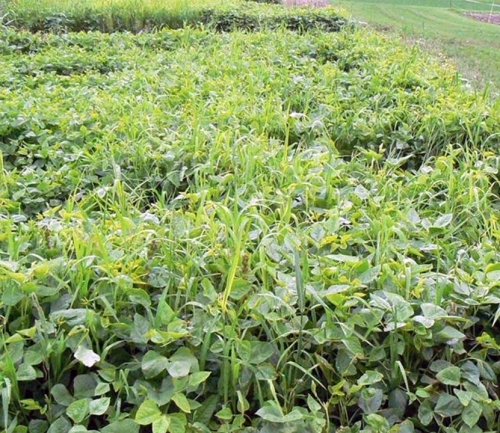
cowpeas and japanese millet

sorgum sudangrass


